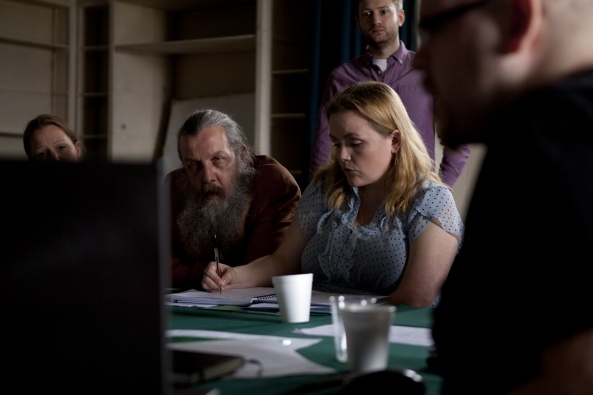
We skirted around talking about it yesterday, but today we know what The Original Writer Alan Moore is up to: it’s an open source comic making app.
Called “Electricomics,” Moore is helping to launch an open source app that will allow anyone to make digital comics. Hoping to do so in a way that has “never been addressed before,” the app will seek to test the limits of digital comics — though what this means is not particularly clear yet. The app itself created by Ocasta Studios, Moore is leading a team with Dr Alison Gazzard, a lecturer in Media Arts at the London Knowledge Lab, as well as Daniel Merlin Goodbrey, described as a “pioneer in the field of experimental digital comics.”
Electricomics will also come with a 32-page comic showing off four different stories, including Alan Moore writing “Big Nemo,” an older version of Little Nemo, and more from Peter Hogan, Garth Ennis, Peter Snejbjerg, Leah Moore and John Reppion.
Moore has always tried to push the comic medium, and there’s already a bevy of talented creators pushing the digital medium far and fast. It will be interesting to see what Moore has in store for Electricomics that makes it so different, but we’ll certainly be watching.
For the full press release from Electricomics, please see below.
Electricomics Press Release
The most famous modern comic book writer in the world, Alan Moore, is leading a research and development project to create an app enabling digital comics to be made by anyone.
Already known for revolutionising the comic book industry in the 1980s, Moore is pushing boundaries again with Electricomics – an app that is both a comic book and an easy-to-use open source toolkit. Being open source and free, the app has wide potential not just for industry professionals, but also businesses, arts organisations and of course comic fans and creators everywhere.
“Personally, I can’t wait,” said Moore. “With Electricomics, we are hoping to address the possibilities of comic strips in this exciting new medium, in a way that they have never been addressed before.
“Rather than simply transferring comic narrative from the page to the screen, we intend to craft stories expressly devised to test the storytelling limits of this unprecedented technology. To this end we are assembling teams of the most cutting edge creators in the industry and then allowing them input into the technical processes in order to create a new capacity for telling comic book stories.
“It will then be made freely available to all of the exciting emergent talent that is no doubt out there, just waiting to be given access to the technical toolkit that will enable them to create the comics of the future.”
Electricomics will be a 32-page showcase with four very different original titles:
Big Nemo – set in the 1930s, Alan Moore revisits Winsor McCay’s most popular hero
Cabaret Amygdala – modernist horror from writer Peter Hogan (Terra Obscura)
Red Horse – on the anniversary of the beginning of World War One, Garth Ennis (Preacher, The Boys) and Danish artist Peter Snejbjerg (World War X) take us back to the trenches
Sway – a slick new time travel science fiction story from Leah Moore and John Reppion (Sherlock Holmes – The Liverpool Demon, 2000 AD)
Electricomics will be self published by Moore and long time collaborator Mitch Jenkins as Orphans of the Storm, and funded by the Digital R&D Fund for the Arts. As a publicly funded research and development project, Electricomics will be free to explore the possibilities of the comic medium, without the constraints of the industry.
The app will be built by Ocasta Studios, under the guidance of Ed Moore (no relation). Ocasta create apps for the likes of Virgin Media, Vodafone, Harveys and The Register. They are excited to be making their first foray into the world of comics.
The research team will be led by Dr Alison Gazzard, who has published widely on space, time and play in interactive media, and is a Lecturer in Media Arts at the London Knowledge Lab, Institute of Education. Joining her, Daniel Merlin Goodbrey is a pioneer in the field of experimental digital comics and senior lecturer at The University of Hertfordshire.
Continued belowMoore’s daughter Leah will edit the project, having created the 150 page digital comic The Thrill Electric for C4 Education in 2011.
About the Digital R&D Fund for the Arts
The Digital R&D fund for the Arts is a £7 million fund to support collaboration between organisations with arts projects, technology providers, and researchers. It is a partnership between Arts Council England (www.artscouncil.org.uk), Arts and Humanities Research Council (www.ahrc.ac.uk) and Nesta (www.nesta.org.uk).
We want to see projects that use digital technology to enhance audience reach and/or develop new business models for the arts sector. With a dedicated researcher or research team as part of the three-way collaboration, learning from the project can be captured and disseminated to the wider arts sector.
Every project needs to identify a particular question or problem that can be tested. Importantly this question needs to generate knowledge for other arts organisations that they can apply to their own digital strategies.
Discover more at http://www.electricomics.net



